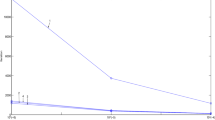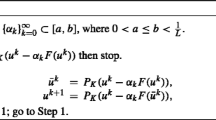Abstract
Extra-gradient method and its modified versions are direct methods for variational inequalities VI(Ω, F) that only need to use the value of function F in the iterative processes. This property makes the type of extra-gradient methods very practical for some variational inequalities arising from the real-world, in which the function F usually does not have any explicit expression and only its value can be observed and/or evaluated for given variable. Generally, such observation and/or evaluation may be obtained via some costly experiments. Based on this view of point, reducing the times of observing the value of function F in those methods is meaningful in practice. In this paper, a new strategy for computing step size is proposed in general extra-gradient method. With the new step size strategy, the general extra-gradient method needs to cost a relatively minor amount of computation to obtain a new step size, and can achieve the purpose of saving the amount of computing the value of F in solving VI(Ω, F). Further, the convergence analysis of the new algorithm and the properties related to the step size strategy are also discussed in this paper. Numerical experiments are given and show that the amount of computing the value of function F in solving VI(Ω, F) can be saved about 12–25% by the new general extra-gradient method.
Similar content being viewed by others
References
Auslender A. (1976) Optimisation Méthodes Numériques. Masson, Paris
Fancchinei, F., Pang, J.S.: Finite-dimensional Variational Inequalities and Complementarity Problems. vol. 1. Springer, Berlin, Heidelberg New York (2003)
Fancchinei, F., Pang, J.S.: Finite-dimensional Variational Inequalities and Complementarity Problems. vol. 2. Springer, Berlin, Heidelberg New York (2003)
Ferris M.C., Pang J.S. (1997) Engineering and economic applications of complementarity problems. SIAM Rev. 39: 669–713
Fletcher R. (1985) Practical Methods of Optimization. Wiley, New York
Fukushima M. (1996) The primal Douglas-Rachford splitting algorithm for a class of monotone mappings with application to the traffic equilibrium problem. Math. Program. 72: 1–15
Goldstein A.A. (1964) Convex programming in Hilbert space. Bull. Am. Math. Soc 70: 709–710
Harker P.T., Pang J.S. (1990) A damped newton method for the linear complementarity problem. Lect. Appl. Math. 26: 265–284
Harker P.T., Pang J.S. (1990) Finite-dimensional variational inequality and nonlinear complementarity problems: A survey of theory algorithms and applications. Math. Program. 48: 161–220
He B.S. (1994) A new method for a class of linear variational inequalities. Math. Program. 66: 137–144
He B.S. (1997) A class of projection and contraction methods for monotone variational inequalities. Appl. Math. Optimization 35: 69–76
He B.S., Yang H., Zhang C.S. (2004) A modified augmented Lagrangian method for a class of monotone variational inequalities. Eur. J. Oper. Res. 159: 35–51
He B.S., Yuan X.M., Zhang J.J.Z. (2004) Comparison of two kinds of prediction-correction methods for monotone variational inequalities. Comput. Optimization Appl. 27: 247–267
Kanzow C., Fukushima M. (1998) Solving box constrained variational inequalities by using the natural residual with D-gap function globalization. Oper. Res. Lett. 23: 45–51
Khobotov E.N. (1987) Modification of the extragradient method for solving variational inequalities and certain optimization problems. USSR. Comput. Math. Phys. 27: 120–127
Korpelevich G.M. (1976) The extragradient method for finding saddle points and other problems. Ekon. Matematchskie Metody 12: 747–56
Levitin E.S., Polyak B.T. (1966) Constrained minimization problems. USSR Comput. Math. Math. Phys. 6: 1–50
Nagurney, A.: Network economics: A Variational Inequality Approach. Revised 2nd edn. Kluwer Academic Publishers Dordrecht, (1999)
Peng J.M., Fukushima M. (1999) A hybrid newton method for solving the variational inequality problem via the D-gap function. Math. Program. 86: 367–386
Qi L., Sun D. (2002) Smoothing functions and a smoothing newton method for complementarity and variational inequality problems. J. Optimization Theory appl. 113: 121–148
Sun D. (1994) A projection and constraction method for the nonlinear complementarity problem and its extensions. Math. Num. Sin. 16: 183–194
Wang Y.J., Xiu N.H., Wang C.Y. (2001) A new version of extragradient method for variational inequality problems. Compu. Math. Appl. 42: 969–979
Zangwill, W.I.: Nonlinear programming: A united approach. Prentice Hall, Englewood Cliffs, NJ (1969)
Author information
Authors and Affiliations
Corresponding author
Rights and permissions
About this article
Cite this article
Xu, M.H., Yuan, X.M. & Huang, Q.L. An improved general extra-gradient method with refined step size for nonlinear monotone variational inequalities. J Glob Optim 39, 155–169 (2007). https://doi.org/10.1007/s10898-006-9129-6
Received:
Accepted:
Published:
Issue Date:
DOI: https://doi.org/10.1007/s10898-006-9129-6




